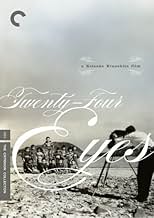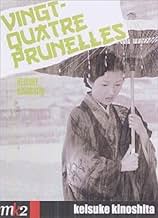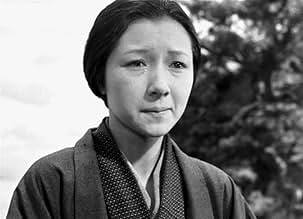NOTE IMDb
8,0/10
3,1 k
MA NOTE
L'institutrice Hisako Oishi tisse un lien affectif avec ses élèves et leur enseigne diverses vertus, tout en s'inquiétant de leur avenir.L'institutrice Hisako Oishi tisse un lien affectif avec ses élèves et leur enseigne diverses vertus, tout en s'inquiétant de leur avenir.L'institutrice Hisako Oishi tisse un lien affectif avec ses élèves et leur enseigne diverses vertus, tout en s'inquiétant de leur avenir.
- Réalisation
- Scénario
- Casting principal
- Récompenses
- 10 victoires et 1 nomination au total
Avis à la une
For English speaking people, there are not many movies available on DVD starring Hideko Takamine. This is one, and it is a masterpiece. Ms. Takamine plays a schoolteacher in a small Inland Sea village in Japan. The movie's time line is twenty years, from 1928 to 1948. These turbulent times affect the students she teaches, some of whom went off to war. There are many tears in this film, from the children and Takamine's character. The fact that "Auld Lang Syne" is used at times for background music heightens the feelings of loss & sadness, which does make up some of the story. This is somewhat of an anti-war film, but only as it affects the children and the teacher. Ms. Takamine is luminous in this role, as she is in every movie I've ever seen her in. The fact that the director Kinoshita Keisuke also directed her in "Carmen Comes Home" (the first ever Japanese film in color), a film light years away from this one, shows off their versatility in their craft. The only complaint I have is small, that the subtitles are somewhat annoying, since they are sometimes out of sync. However, a great movie is a great movie. This film won the Golden Globe for Best Foreign Language Film. It is a richly deserved honor.
24 eyes is based on a novel that was written in 1952 by Sakae Tsuboi. It's a story about the life of a school teacher in three different time period (1928 to 1947) of Japan, namely pre- war period, during war, and post war Japan. Sakae was also born in Shodo-shima island like the main character of this movie Ms. Ooishi (Hideko Takamine). The movie has a strong anti-war theme to it as well as showing how tough life was when Japan was still a third world country.
In 1928 new school teacher named Ooishi (her first name is never mentioned in the movie) comes to the satellite school in Shodo-shima island, where there are 12 children. The place is a real country side and Ms Ooishi has a problem with the local customs, but she try's to be a good teacher. One day the children plays a prank and Ms. Ooishi falls into a hole dug by the students. She severs her Achilles tendon and has to take a long leave of absence. But the children wanting to see her travels a long way to see her, braving hunger and loneliness. Ms. Ooishi recovers, but soon she is assigned to the main school. Due to depression, many of her former students has to quit school and go to work. Ms. Ooishi gets married, but she quits being a teacher saying she hates the brain washing pro military education. War starts and many of her students and even her husband dies in the war. Long war ends and Ms. Ooishi returns to the satellite school. Many of her students are the children of her former students. As she gives roll calls, memory hits her hard, and she starts crying. Children not knowing the reason, call her cry baby teacher. Soon old students suggests a class reunion. Her old students, now grown adult gives Ms. Ooishi a bicycle like the one she used to ride to school. Ms. Ooishi cry's again seeing her old students once again.
The movie won the Golden Globe award's best foreign movie, and also won the first place in Japanese movie magazine, surpassing Kurosawa's The Seven Samurai that came out the same year.
Movie tells the life of children living in the country, but it also shows how war affected their lives. In the 1930s, Japan was trying to become one of the great nations. Their role model were United States, France, England, Dutch, and Germany. They saw that other great nations were using colonization to expand their empire, and decided to create their own empire in the name of Great Asian Co-prosperity Region. Japan won the Russo Japanese war and was big headed about their military might. All this worked for Japan to charge head in into militarism. While the Japanese navy who had their over seas envoy knew the foolishness of fighting the allied force, the army headed by Tojo insisted on taking the country to war which had deadly consequence for Japan and its people. The movie shows how very ordinary people got entangled in the tides of time, and young and impressionable people went willingly to war thinking it was patriotism. Now China who was on the receiving end during this war is only a hair trigger away from making the same mistake.
What is most striking about the movie is the innocence people had at the time. Despite their hard life they weren't crooked, or violent. Each character in this movie had an endearing qualities. Keisuke Kinoshita who was perhaps Japan's first gay director was a master at depicting people in their family settings. Hideko Takamine marries the assistant director of this movie Zenzo Matsuyama a year after this movie was made.
All this makes this one of a kind memorable movie of all time. Once you've seen it, you'll never forget it.
In 1928 new school teacher named Ooishi (her first name is never mentioned in the movie) comes to the satellite school in Shodo-shima island, where there are 12 children. The place is a real country side and Ms Ooishi has a problem with the local customs, but she try's to be a good teacher. One day the children plays a prank and Ms. Ooishi falls into a hole dug by the students. She severs her Achilles tendon and has to take a long leave of absence. But the children wanting to see her travels a long way to see her, braving hunger and loneliness. Ms. Ooishi recovers, but soon she is assigned to the main school. Due to depression, many of her former students has to quit school and go to work. Ms. Ooishi gets married, but she quits being a teacher saying she hates the brain washing pro military education. War starts and many of her students and even her husband dies in the war. Long war ends and Ms. Ooishi returns to the satellite school. Many of her students are the children of her former students. As she gives roll calls, memory hits her hard, and she starts crying. Children not knowing the reason, call her cry baby teacher. Soon old students suggests a class reunion. Her old students, now grown adult gives Ms. Ooishi a bicycle like the one she used to ride to school. Ms. Ooishi cry's again seeing her old students once again.
The movie won the Golden Globe award's best foreign movie, and also won the first place in Japanese movie magazine, surpassing Kurosawa's The Seven Samurai that came out the same year.
Movie tells the life of children living in the country, but it also shows how war affected their lives. In the 1930s, Japan was trying to become one of the great nations. Their role model were United States, France, England, Dutch, and Germany. They saw that other great nations were using colonization to expand their empire, and decided to create their own empire in the name of Great Asian Co-prosperity Region. Japan won the Russo Japanese war and was big headed about their military might. All this worked for Japan to charge head in into militarism. While the Japanese navy who had their over seas envoy knew the foolishness of fighting the allied force, the army headed by Tojo insisted on taking the country to war which had deadly consequence for Japan and its people. The movie shows how very ordinary people got entangled in the tides of time, and young and impressionable people went willingly to war thinking it was patriotism. Now China who was on the receiving end during this war is only a hair trigger away from making the same mistake.
What is most striking about the movie is the innocence people had at the time. Despite their hard life they weren't crooked, or violent. Each character in this movie had an endearing qualities. Keisuke Kinoshita who was perhaps Japan's first gay director was a master at depicting people in their family settings. Hideko Takamine marries the assistant director of this movie Zenzo Matsuyama a year after this movie was made.
All this makes this one of a kind memorable movie of all time. Once you've seen it, you'll never forget it.
Compared to a film like "Pigs And Battleships", or even "I Live In Fear"; Kinoshita's film is a middlebrow, mainstream, even sentimental take on the Japan's war years and it's aftermath.
Still, the film is graceful and touching, with what Pauline Kael called "concealed art." Kinoshita's approach seems to be to take potently maudlin situations, and film them from an objective distance; with as direct and simple emotion as possible.
This may short change the great Takamine a bit; we seem to be an hour into the film before the great actress receives a close up. Still, her performaces gains power as the film goes on.
Though politics are kept in the background, as perhaps they had to in a Japanese film of this nature; but there is an anger lurking in the backgroud; an inditement of a culture that would waste the strength of it's woman and worse; reduce it's men to cannon fodder. Was it something in Japanese life; rather than just it's military, that led to it's disasters? Even the country's great filmmakers seem hesitant to speculate. In any event, another strong film of interest to all those who have fallen under the spell of great Japanese film.
Still, the film is graceful and touching, with what Pauline Kael called "concealed art." Kinoshita's approach seems to be to take potently maudlin situations, and film them from an objective distance; with as direct and simple emotion as possible.
This may short change the great Takamine a bit; we seem to be an hour into the film before the great actress receives a close up. Still, her performaces gains power as the film goes on.
Though politics are kept in the background, as perhaps they had to in a Japanese film of this nature; but there is an anger lurking in the backgroud; an inditement of a culture that would waste the strength of it's woman and worse; reduce it's men to cannon fodder. Was it something in Japanese life; rather than just it's military, that led to it's disasters? Even the country's great filmmakers seem hesitant to speculate. In any event, another strong film of interest to all those who have fallen under the spell of great Japanese film.
Mostly unknown and frequently dismissed in the West, this film is often considered by the Japanese to be one of their very best films, if not their best. I concur with the Japanese. I can understand the issues people have with it, namely that it is overly sentimental, but I think it mostly earns the tears that are shed over it. It's a film in the classic teacher genre, like Goodbye Mr. Chips. Hideko Takamine plays Hisako Oishi, a young woman who begins the movie as a first grade teacher on a small island in 1928. Being a small population, she ends up staying with the same students for several years. The film ends in the 1950s, so you kind of know what will probably happen to her male students, and what she and her female students will have to experience. It may be somewhat predictable, but it's incredibly heartbreaking. The film is beautifully made, and filled with Japanese folk songs (strangely, the score of the film is made up of a bunch of Western music, including "Bonnie Annie Laurie" and "There's No Place Like Home"; it's definitely a flaw). Takamine, who starred in several Mikio Naruse films around the same time, is exceptional.
Nearly everyone who rated this film gave it 10/10, and it's easy to see why. This is a wonderful and bittersweet story about a teacher and her first twelve students, the "24 eyes" of the title, on a fairly remote island community. The story sweeps over about 20 years, from the students in the first grade, then the sixth, then as later teenagers, then four years later. The story begins in the late 1920s, and thus spans a turbulent time in Japanese history, which of course impacts greatly on the characters, even on a fairly isolated island.
Hideko Takamine is perhaps my favourite Japanese actress. This luminous and loveable women with the dazzling smile is a joy to behold and, playing the object of much affection from the children (though only sometimes from the adults), creates a wonderful feeling. Man, I wish I'd had her as a teacher in lower primary school.
There's a strong sense of community in this story, which is one of its strong points, but it is not always a positive thing for the characters. The older women gossip, of course, about the 'modern' new teacher, because she rides a bike and wears western clothes.
The director expertly presses all the emotional buttons of the audience. There are some people who detest this sort of thing, but I'm a sucker for it. In the hands of an expert director, and for the purposes of entertainment, there's nothing wrong with being taken on a emotional roller-coaster ride. There are some high points and many sad events in the story, which moves along at a pace which is sometimes leisurely but never dull.
This film is not free of faults. Aside from the very overt emotional manipulation, there are several tunes which are vastly overused. For instance, "auld lang syne" is played at least ten times.
Also, and most surprisingly, Hideko's range is limited. Despite two and a half hours, together with Hideko being the undisputed star, she shows only three expressions during the entire proceedings. Comparison to the superb HAPPINESS FOR US ALONE shows this clearly. In HFUA, Hideko plays a deaf-mute and uses her wonderfully expressive face to full effect.
But these are minor points, and no reason to mark it down from a perfect score. This is a must-see for anyone who loves film.
Hideko Takamine is perhaps my favourite Japanese actress. This luminous and loveable women with the dazzling smile is a joy to behold and, playing the object of much affection from the children (though only sometimes from the adults), creates a wonderful feeling. Man, I wish I'd had her as a teacher in lower primary school.
There's a strong sense of community in this story, which is one of its strong points, but it is not always a positive thing for the characters. The older women gossip, of course, about the 'modern' new teacher, because she rides a bike and wears western clothes.
The director expertly presses all the emotional buttons of the audience. There are some people who detest this sort of thing, but I'm a sucker for it. In the hands of an expert director, and for the purposes of entertainment, there's nothing wrong with being taken on a emotional roller-coaster ride. There are some high points and many sad events in the story, which moves along at a pace which is sometimes leisurely but never dull.
This film is not free of faults. Aside from the very overt emotional manipulation, there are several tunes which are vastly overused. For instance, "auld lang syne" is played at least ten times.
Also, and most surprisingly, Hideko's range is limited. Despite two and a half hours, together with Hideko being the undisputed star, she shows only three expressions during the entire proceedings. Comparison to the superb HAPPINESS FOR US ALONE shows this clearly. In HFUA, Hideko plays a deaf-mute and uses her wonderfully expressive face to full effect.
But these are minor points, and no reason to mark it down from a perfect score. This is a must-see for anyone who loves film.
Le saviez-vous
- AnecdotesAccording to Japanese film critic and historian Tadao Satô, in casting this film about a schoolteacher and her relationships with her pupils over many years, director Keisuke Kinoshita very cleverly chose pairs of look-alike siblings to portray the students. So for those scenes set in later years, Kinoshita simply substituted the older siblings for the younger ones, so that the schoolchildren appeared to "grow" before the audience's eyes.
- ConnexionsReferenced in L'obsédé en plein jour (1966)
- Bandes originalesAnnie Laurie
Meilleurs choix
Connectez-vous pour évaluer et suivre la liste de favoris afin de recevoir des recommandations personnalisées
- How long is Twenty-Four Eyes?Alimenté par Alexa
Détails
- Durée
- 2h 36min(156 min)
- Couleur
- Mixage
- Rapport de forme
- 1.37 : 1
Contribuer à cette page
Suggérer une modification ou ajouter du contenu manquant






















